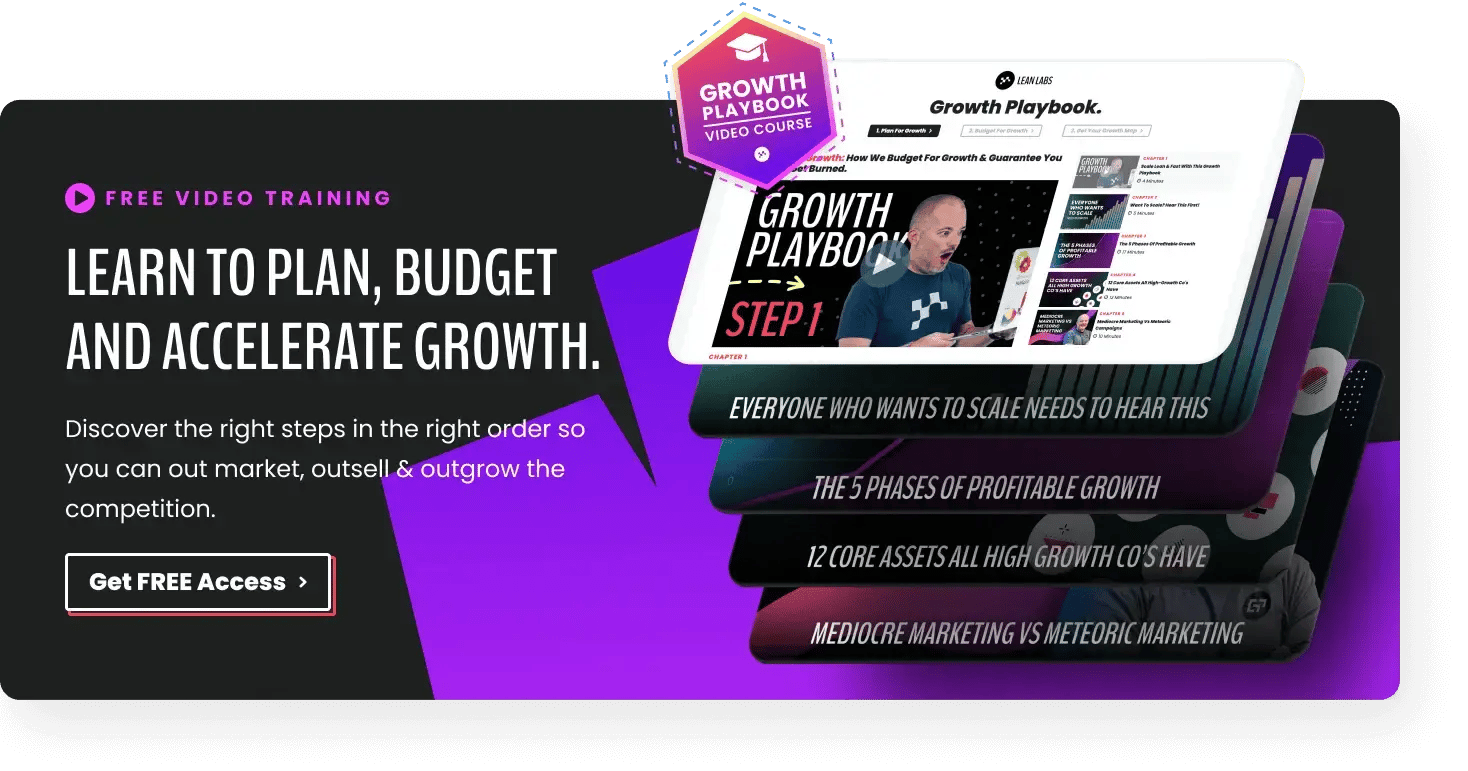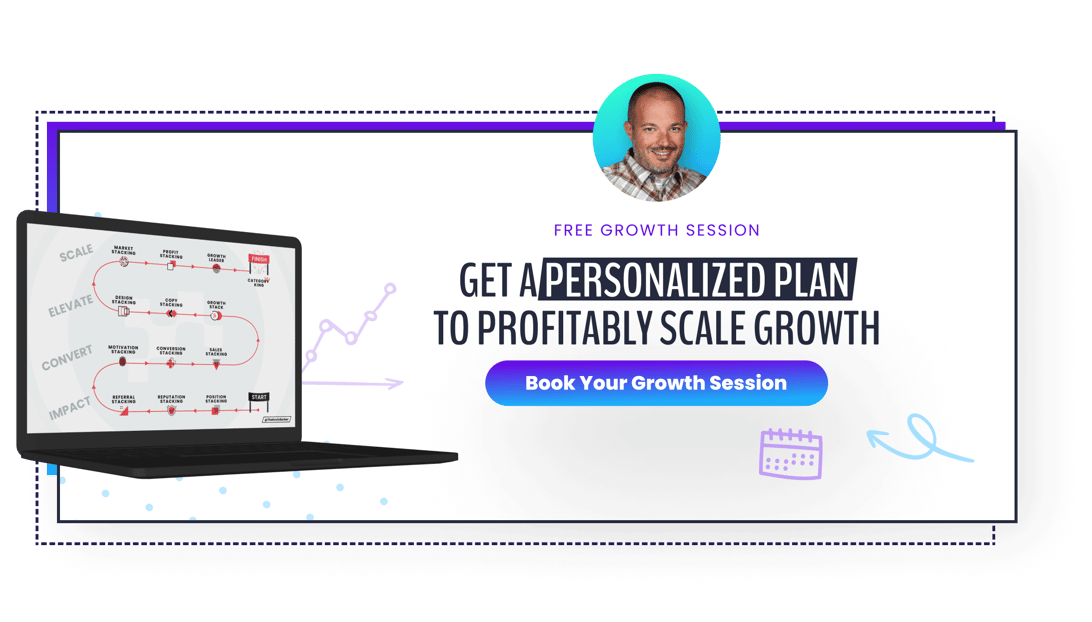Probably not. You’d map out the course, ensure you had the suitable clothing, create a training plan, check out the competition, and prepare for the big day.
Similarly, you cannot rush to market when launching your product or service in the B2B space. It’s a waste of time and money. Instead, high-growth companies first focus on building a growth system for profitable customer acquisition. Rushing to market without considering your website, marketing plan, and the conversion process will likely end in tears.
In this article, you’ll discover six simple steps to help crush your go-to-market strategy and ensure your B2B solution reaches your ideal customers the first time.
VIDEO TRAINING
Nail Your Go-To-Market Strategy With This Proven Playbook.
Learn to plan, budget, and accelerate growth with our exclusive video series. You’ll discover:
- The 5 phases of profitable growth
- 12 core assets all high-growth companies have
- Difference between mediocre marketing and meteoric campaigns
Thanks for submitting the form!
We'll review the information you've submitted and respond to you just as soon as possible.
6 Simple Steps: Build a Winning B2B Go To Market Strategy
A go-to-market strategy is a thorough, actionable plan to launch your product. Through market research, competitive analysis, messaging and launching your product, you can predict its performance against data.
Without a solid go-to-market strategy, you risk plowing weeks or months of hard work developing your product only to try and sell it to the wrong audience. Don’t make the mistake of thinking that your next product will be just as successful because you already have products selling to a specific market. You need a strategy for every product you want to launch.
Microsoft learned this the hard way. Their 2009 ad campaign, now famously known as the “Oh my gosh, I’m gonna puke” commercial, was meant to introduce Internet Explorer 8.
The woman puking saw something so vile on her husband’s computer that it made her vomit multiple times. The takeaway is if her husband had Internet Explorer 8, he’d have private browsing. Crazy, right? Microsoft lost sight of its target audience: every computer user worldwide.
If you want to get your go-to-market strategy right the first time, follow these six simple steps.
Build a Winning B2B Go To Market Strategy
- Get to know your market
- Write a killer unique value proposition
- Build your website based on market research
- Sell a solution, not a product
- Consider your pricing model
- Set KPIs and success metrics
1. Get to Know Your Market
Know Your Market
The first step to launching your product is understanding your target market. Conduct market research to see where it fits and how it relates to the market. Start by thinking of your product and market in four ways:
- Sell a new product to a new market
- Sell a new product to an existing market
- Sell an existing product to a new market
- Sell an existing product to an existing market
Once you know what you’re trying to achieve, think about your competitors. Plot out a competitor landscape.
- Which products are already out there similar to yours or provide a similar solution?
- How is your product different?
- Is your pricing different?
Use storytelling and messaging to convey those differences, convince buyers to learn more about your product, or sign up for a free trial.
Pro tip: Check out your competitors’ marketing plan. What’s working for them? What isn’t?
Segment Your Market
Where is your audience? I don’t mean which country. I mean, where do they hang out? What makes them tick? Wherever they are, you need to be there too.
Part of segmenting your market is developing a buyer persona. Create a clear picture of your ideal customer who’s most likely to buy your product. Use something like this:

Fill in the blanks. Knowing this information helps segment your audience, and the deeper you go, the more easily you can target your persona with stellar messaging.
Position Your Product
Take Evan from the image above; how does your product solve his top 3 problems? Why should he believe you? Put that into your messaging. To take your message to the next level, write a killer unique value proposition (read on to find out how) and use language that helps you stand out from your competitors.
Your messaging shouldn’t simply be a list of features and benefits. Think about how you want your audience to perceive your product or service and how you can communicate the value of your product. This will also guide your sales team.
Your website is your best salesman. When a visitor lands on your website, within seconds, they should know three things:
- How your solution solves their problem
- The specific benefits
- Why should they buy from you instead of your competitors?
It needs to be easy to read and understand. Take Lean Labs, for example:

Our UVP says who we help, what we help with, how, and why we differ. It’s not about us, we don’t mention any features, and our ideal client knows the results they’ll get when they hire us.
Your UVP is a promise to your customers. Here’s how to write it.
- Communicate how you solve a problem. Don’t make it about you.
- Keep it short and straightforward.
- Explain what you will do for your clients
- Lastly, align your UVP with your primary call to action. An incredible value proposition and compelling CTA are a winning combination.
3. Build Your Website Based on Your Market Research
To reiterate: your website is your best salesperson. It’s no use developing the rest of your go-to-market strategy and pairing it with a subpar website. Most B2C companies expect customers to complete a transaction within one website visit.
B2B companies don’t expect transactions to happen immediately. B2B sales cycles tend to be longer. A prospect pretty much wants to date your company. They’re not going to marry you after the first date! The buyer journey consists of several interactions across various channels before leading to a conversion. Then you can pop the question.
Your website needs to captivate and engage your prospect by conveying the value of your solution. You need to tell your prospect what you want them to do by creating compelling calls-to-action (CTA) that pushes them to the next step on their journey.
3 Tips:
- Ensure your website displays the problem you solve.
- Place your UVP above the fold, so it’s one of the first things your prospect reads.
- Create clear and compelling CTAs
4. Sell a Solution, Not a Product
When you’re thirsty (problem), you don’t buy water because you like the color, branding, or bottle shape. You buy the water to quench your thirst (solution).
That might seem too simple, but people like simple. They want a solution to their problems. Sorry to hurt your feelings, but they don’t care how fancy the product is. In all your marketing, sell the solution.
- How will your client feel when they purchase your product?
- What’s the long-term payoff?
- What’s the emotional payoff?
- How can you solve their pain points?
The more you prove to a potential customer that you understand and empathize with their situation, the more trust you build.
Remember we talked about positioning your product and communicating its value? If your sales team can answer questions the same way you can, you can align your whole team to show your customer that their happiness comes first at every stage of the buyer journey.
5. Consider Your Pricing Model
There are three avenues to explore when pricing your product:
- Disrupt the market: Provide a simpler, more affordable alternative to the complex products already in your chosen market.
- Differentiate your solution: Create a specialized product and nail your messaging. Define a niche in your market and set higher prices.
- Dominate the market: provide a better product than your competitors. Doing so means you can price your product higher.
How you communicate the value of your product in each scenario determines whether your audience will buy. Next, consider the actual model you’ll use.
- User-based: Charge businesses based on the number of users who can access or use the product. Prices are higher if there are more users. It’s a simple model, but you risk companies sharing a single login for multiple users.
- Usage-based: Charge businesses based on how often they use your products. Again, more usage means a higher price. It’s appealing for companies who want to anticipate costs but can be frustrating if monthly usage changes and bills vary.
- Tiered: Stack up your features and set a different price point depending on the number of features a business needs. Offering a free or basic package allows customers to experience your product. You can then charge more for features that bring more value and cost more to create.
- Flat Rate: Offer one product or service and include all features for one price. A flat rate model is simple and ensures costs are predictable.
6. Set Key Performance Indicators (KPIs) and Success Metrics
How will you review your progress and meet your goals within a given period? Before launching your product, you need to determine what success looks like. Set expectations, and set SMART goals. That doesn’t mean you should track every metric. Depending on your business and pricing model, determine the metrics most important to you.
In the B2B world, you need to drive traffic to your website (remember: it’s your best salesperson); but traffic alone isn’t indicative of success. You need the right kind of traffic. How will you know? Track conversions on your offers and CTAs, email open and clickthrough rates, and determine if your messaging aligns with your customers’ views.
Set benchmarks, targets, and who’s responsible for each marketing KPI. They will be responsible for reporting on the KPI, too. Here’s a quick breakdown:
- Establish a baseline
- Track progress over time
- Improve on what’s working
- Change what isn’t working
- Hone your strategy
A Winning B2B Go To Market Strategy: It’s All in the Planning
It might seem like a lot to take on just to get your product to market, but it’s better to get it right the first time than to fail and reinvest time, effort, and money. You need to establish your market, how you’ll position your solution, set goals, and go to market confident you’ve done all you can to guarantee success.
Don’t do it alone. Lean Labs is an outsourced growth team that provides an unparalleled growth system to develop your go-to-market strategy, website, marketing, and conversion rate optimization to drive massive growth in your business. We work with innovative B2B and Tech companies that deserve to grow.
Find out exactly what we’d do if we were your Growth team by booking a Growth Mapping Session today!







